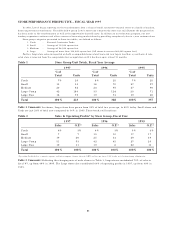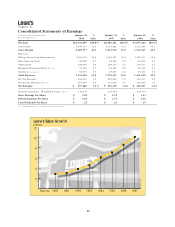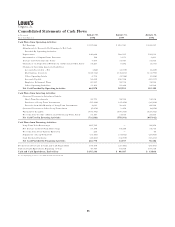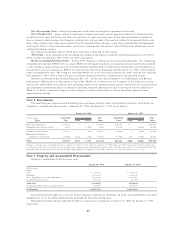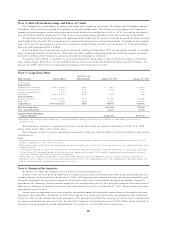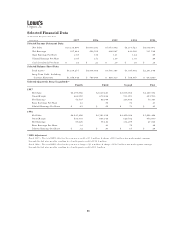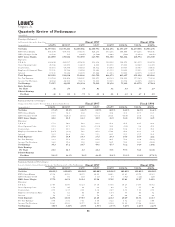Lowe's 1997 Annual Report Download - page 33
Download and view the complete annual report
Please find page 33 of the 1997 Lowe's annual report below. You can navigate through the pages in the report by either clicking on the pages listed below, or by using the keyword search tool below to find specific information within the annual report.
(SFAS 123), “Accounting for Stock-Based Compensation,” the Company’s net earnings and earnings per share (EPS) amounts
for 1997 and 1996 would approximate the following proforma amounts (in thousands except per share data):
1997 1996
As Reported Proforma As Reported Proforma
Net Earnings $357,484 $352,217 $292,150 $291,411
Basic EPS $ 2.05 $ 2.02 $ 1.74 $ 1.74
Diluted EPS $ 2.05 $ 2.02 $ 1.71 $ 1.71
The fair values of each option granted on the date of grant were estimated as $19.12 for options granted on December 5, 1997,
$17.09 for options granted on May 30, 1997 and $16.99 for options granted on December 6, 1996, using the Black-Scholes
option-pricing model with the following assumptions, respectively: expected volatility of 34%, 37% and 38%, expected dividend
yield of 0.6% for each grant; risk-free interest rate of 5.9%, 6.5% and 6.0%; and an expected life of 5 years for each grant.
The effects of applying SFAS 123 in this proforma disclosure are not indicative of future amounts.
Note 9, Leases:
The Company leases certain store facilities under agreements with original terms generally of twenty years. Agreements
generally provide for contingent rental based on sales performance in excess of specified minimums. To date, contingent
rentals have been nominal. The leases typically contain provisions for four renewal options of five years each. Certain equip-
ment is also leased by the Company under agreements ranging from two to five years. These agreements typically contain
renewal options providing for a renegotiation of the lease, at the Company’s option, based on the fair market value at that time.
The future minimum rental payments required under capital and operating leases having initial or remaining noncancelable
lease terms in excess of one year are summarized as follows:
Operating Leases Capital Leases
Fiscal Year Real Estate Equipment Real Estate Equipment Total
(In Thousands)
1998 $ 85,053 $ 755 $ 49,093 $ 291 $ 135,192
1999 97,154 708 49,094 291 147,247
2000 96,101 271 49,112 218 145,702
2001 95,841 — 49,132 98 145,071
2002 95,627 — 49,133 98 144,858
Later Years 1,300,892 — 637,798 49 1,938,739
Total Minimum Lease Payments $1,770,668 $1,734 $883,362 $1,045 $2,656,809
Total Minimum Capital Lease Payments $884,407
Less Amount Representing Interest 439,838
Present Value of Minimum Lease Payments 444,569
Less Current Maturities 10,896
Present Value of Minimum
Lease Payments, Less Current Maturities $433,673
Rental expenses under operating leases for real estate and equipment were $65.4 million, $59.2 million and $54.1
million in 1997, 1996 and 1995, respectively.
Note 10, Employee Retirement Plans:
The Company’s contribution to its Employee Stock Ownership Plan (ESOP) is determined annually by the Board of
Directors. The ESOP covers all employees after completion of one year of employment and 1,000 hours of service during that
year. Contributions are allocated to participants based on their eligible compensation relative to total eligible compensation.
The Board authorized contributions totaling 13% of eligible compensation for 1997 and 14% of eligible compensation for 1996
and 1995. Contributions may be made in cash or shares of the Company’s common stock and are generally made in the following
year. ESOP expense for 1997, 1996 and 1995 was $63.1, $61.1 and $40.1 million, respectively.
At January 30, 1998, the Employee Stock Ownership Trust held approximately 10.2% of the outstanding common stock
of the Company. Shares allocated to ESOP participants’ accounts are voted by the trustee according to participants’ voting
instructions.
The Board of Directors determines contributions to the Company’s Employee Savings and Investment Plan (ESIP) each
year based upon a matching formula applied to employee contributions. All employees are eligible to participate in the ESIP
on the first day of the month following completion of one year of employment. Company contributions to the ESIP for 1997,
1996 and 1995 were $8.7, $7.2 and $6.0 million, respectively. The Company’s common stock is an investment option for
participants in the ESIP. At January 30, 1998, the ESIP held approximately 0.7% of the outstanding common stock of the
Company. Shares held in the ESIP are voted by the trustee as directed by an administrative committee of the ESIP.
31


